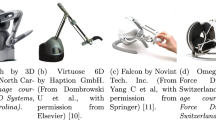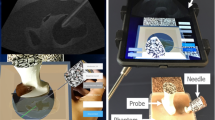Abstract
In this paper, a high-immersive surgical training system for renal biopsy using holographic demonstration and haptic feedback is presented to push the limitation of virtual medical training development. Proposed system is including: holographic visual rendering pipeline reconstructed by the patient-specific CT images; haptic rendering pipeline implemented by the dual-hands 6-DOF haptic devices connected with surgical instruments of image guide and immersive 3D display learning operating room environment. Twenty-four medical students and eight experienced thoracic surgeons from the Yunnan First People’s Hospital are invited to evaluate our holographic-based training system through the subjective and objective assessment test, respectively. Experiment result from the face, content, improvement, and construct evaluations demonstrated a high performance than the existing VR-based trainer, especially the puncture accuracy of medical students’ group, was improved by 30.8% after training.









Similar content being viewed by others
References
Al-Ayyoub M, AlZu’bi S, Jararweh Y, Shehab MA, Gupta BB (2018) Accelerating 3D medical volume segmentation using GPUs. Multimed Tools Appl 77:4939–4958
Atat R, Liu L, Wu J, Li G, Ye C, Yang Y (2018) Big data meet cyber-physical systems: a panoramic survey. IEEE Access 6:73603–73636
Brinkman WM, Tjiam IM, Buzink SN (2013) Assessment of basic laparoscopic skills on virtual reality simulator or box trainer. Surg Endosc 27(10):3584–3590
Bucioli AAB et al (2018) Holographic real time 3D heart visualization from coronary tomography for multi-place medical diagnostics. In: Proceedings—2017 IEEE 15th international conference on dependable, autonomic secure computing 2017 IEEE 15th international conference on pervasive intelligence and computing 2017 IEEE 3rd international conference on big data intelligence and computing, vol 2018, pp 239–244
Chen X, Lin Y, Wang C, Shen G, Wang X (2012) A virtual training system using a force feedback haptic device for oral implantology. Lecture notes in computer science (including subseries lecture notes in artificial intelligence and lecture notes in bioinformatics)
Coles TR, Meglan D, Member S, John NW (2011) The role of haptics in medical training simulators: a survey of the state of the art. IEEE Trans Haptics 4(1):51–66
Dorgham O, Al-Rahamneh B, Almomani A, Al-Hadidi M, Khatatneh KF (2017) Enhancing the security of exchanging and storing DICOM medical images on the cloud. Int J Cloud Appl Comput 8:154–172
Flora A et al (2018) Intelligent medical record management: a diagnosis support system. Int J High Perform Comput Netw 12(4):391–399
Fortmeier D, Mastmeyer A, Schröder J, Handels H (2016) A virtual reality system for PTCD simulation using direct visuo-haptic rendering of partially segmented image data. IEEE J Biomed Health Inform 20(1):355–366
Goléa NEH, Melkemi KE (2019) ROI-based fragile watermarking for medical image tamper detection. Int J High Perform Comput Netw 13:199–210
Halic T, De S (2010) Lightweight bleeding and smoke effect for surgical simulators, In: Proceedings—IEEE virtual reality, pp 271–272
Incekara F, Smits M, Dirven C, Vincent A (2018) Clinical feasibility of a wearable mixed-reality device in neurosurgery. World Neurosurg 118:e422–e427
Iversen P, Brun C (1951) Aspiration biopsy of the kidney. Am J Med 11(3):324–330
Jan S (2019) Assessing complex evolving cyber-physical systems (case study: smart medical devices). Int J High Perform Comput Netw 13(3):294–303
Jarillo-Silva A, Domínguez-Ramírez OA, Parra-Vega V, Ordaz-Oliver JP (2009) Phantom omni haptic device: kinematic and manipulability. In: CERMA 2009—electronics, Robotics and automotive mechanics conference, pp 193–198
Korbet SM (2002) Percutaneous renal biopsy. In: Seminars in nephrology
Kuzhagaliyev T et al (2018) Augmented reality needle ablation guidance tool for irreversible electroporation in the pancreas. In: Medical imaging 2018 image-guided procedures, robotic interventions, and modeling, vol 10576, p 30
Mahmood F et al (2018) Augmented reality and ultrasound education: initial experience. J Cardiothorac Vasc Anesth 32(3):1363–1367
Martín JS, Triviño G, San Martin J, Trivino G (2006) A study of the manipulability of the PHANToM TM OMNI TM Haptic Interface. In: Omni
Matell MS, Jacoby J (1971) Is there an optimal number of alternatives for Likert scale items? Study 1: reliability and validity. Educ Psychol Meas 31:657–674
Mrug M, Bissler JJ (2010) Simulation of real-time ultrasound-guided renal biopsy. Kidney Int 78:705–707
Muhammad G, Alhamid MF, Alsulaiman M, Gupta B (2018) Edge computing with cloud for voice disorder assessment and treatment. IEEE Commun Mag 56(4):60–65
Ni D et al (2011) A virtual reality simulator for ultrasound-guided biopsy training. IEEE Comput Graph Appl 31(2):36–48
Noureldin YA, Fahmy N, Anidjar M, Andonian S (2016) Is there a place for virtual reality simulators in assessment of competency in percutaneous renal access? World J Urol 34:733–739
Page M (2017) Visualization of complex medical data using next-generation holographic techniques
Pham T, Tang A, Jacob C (2017) User-defined gestures for holographic medical analytics
Selmi SY, Fiard G, Promayon E, Vadcard L, Troccaz J (2013) A virtual reality simulator combining a learning environment and clinical case database for image-guided prostate biopsy. In: Proceedings of CBMS 2013—26th IEEE international symposium on computer-based medical systems
Soler L, Marescaux J (2016) Virtual surgical simulation: the first steps in a new training. Springer, Berlin
Stern J, Zeltser IS, Pearle MS (2007) Percutaneous renal access simulators. J Endourol 21:270–273
Tse B, Harwin W, Barrow A, Quinn B, Diego JS, Cox M (2010) Design and development of a haptic dental training system—hapTEL. In: International conference, Eurohaptics 2010, Amsterdam, the Netherlands, July 8–10, 2010. Proceedings, pp 101–108
Ullrich S, Kuhlen T (2012) Haptic palpation for medical simulation in virtual environments. IEEE Trans Vis Comput Graph 18(4):617–625
Vavra P et al (2017) Recent development of augmented reality in surgery: a review. J Healthc Eng 8:1–9
Wang L, Sun Y (2015) Research on evaluation system of upper limb rehabilitation training based on virtual reality interaction. In: Proceedings of the World congress intelligent control and automation, vol 2015, March, pp 2798–2803
Wei L, Najdovski Z, Abdelrahman W, Nahavandi S, Weisinger H (2012) Augmented optometry training simulator with multi-point haptics. In: Conference proceedings—IEEE international conference on systems, man, and cybernetics, pp 2991–2997
Wu J, Guo S, Huang H, Liu W, Xiang Y (2018) Information and communications technologies for sustainable development goals: state-of-the-art, needs and perspectives. IEEE Commun Surv Tutor 20:2389–2406
Xie T, Islam MM, Lumsden AB, Kakadiaris IA (2017) Holographic iRay: exploring augmentation for medical applications. In: Adjunt proceedings 2017 IEEE international symposium on mixed and augmented reality, ISMAR-adjunct 2017, pp 220–222
Yamaguchi T, Yoshikawa H (2018) High resolution computer-generated rainbow hologram. Appl Sci 8(10):1955
Yi N, Guo XJ, Li XR, Xu XF, Ma WJ (2010) The implementation of haptic interaction in virtual surgery, In: Proceedings—international conference on electrical and control engineering ICECE 2010, pp 2351–2354
Zhang Y, Yu CF, Liu JS, Wang G, Zhu H, Na YQ (2013) Training for percutaneous renal access on a virtual reality simulator. Chin Med J (Engl) 126:1528–1531
Author information
Authors and Affiliations
Corresponding authors
Ethics declarations
Conflict of interest
The authors declare that there is no conflict of interest regarding the publication of this paper.
Additional information
Communicated by B. B. Gupta.
Publisher's Note
Springer Nature remains neutral with regard to jurisdictional claims in published maps and institutional affiliations.
Rights and permissions
About this article
Cite this article
Guo, Z., Tai, Y., Qin, Z. et al. Development and assessment of a haptic-enabled holographic surgical simulator for renal biopsy training. Soft Comput 24, 5783–5794 (2020). https://doi.org/10.1007/s00500-019-04341-4
Published:
Issue Date:
DOI: https://doi.org/10.1007/s00500-019-04341-4




